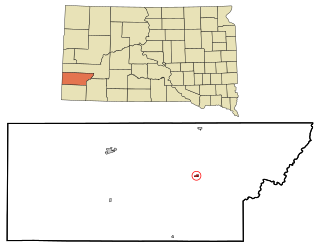
Ludden is a city in Dickey County, North Dakota, United States. The population was 15 at the 2020 census. Ludden was founded in 1886.

Oakes is the most populous city in Dickey County, North Dakota, United States. The population was 1,798 at the 2020 census. Oakes was founded in 1886.

Towner is a city in McHenry County, North Dakota. It is the county seat of McHenry County. The population was 479 at the time of the 2020 census. It is part of the Minot Micropolitan Statistical Area. Towner was founded in 1886.

Broadland is a town in Beadle County, South Dakota, United States. The population was 27 at the 2020 census.

Wolsey is a town in Beadle County, South Dakota, United States. The population was 459 at the 2020 census.

Hecla is a city in Brown County, South Dakota, United States, located only a few miles south of the North Dakota border. The population was 193 at the 2020 census. State Highway 37 runs along the east side of town.

Wakonda is a town in Clay County, South Dakota, United States. The population was 347 at the 2020 census.

Fairburn is a town in Custer County, South Dakota, United States. The population was 60 at the 2020 census.

Faulkton is a city in and county seat of Faulk County, South Dakota, United States. The population was 826 at the 2020 census. The city's nickname is "The Carousel City".

Farmer is a town in Hanson County, South Dakota, United States. It is part of the Mitchell, South Dakota Micropolitan Statistical Area. The population was 15 at the 2020 census.

Fulton is a town in Hanson County, South Dakota, United States. It is part of the Mitchell, South Dakota Micropolitan Statistical Area. The population was 87 at the 2020 census.

Whitewood is a city in Lawrence County, South Dakota, United States. The population was 879 at the 2020 census.

Carthage is a city in Miner County, South Dakota, United States. The population was 127 at the 2020 census.

Hartford is a suburban American city in Minnehaha County, South Dakota, a few miles northwest of Sioux Falls. Its population was 3,354 at the 2020 census.

Quinn is a town in Pennington County, South Dakota, United States. The population was 63 at the 2020 census. The town is the home of the Badlands Observatory, located in the former community hospital, built in 1950.

Wasta(Lakota: wašté) is a town in Pennington County, South Dakota, United States, situated along the Cheyenne River. It had a population of 65 at the 2020 census.

Conde is a city in Spink County, South Dakota, United States. The population was 142 at the 2020 census.

Redfield is a city in and the county seat of Spink County, South Dakota, United States. The population was 2,214 at the 2020 census. The city was named for J. B. Redfield, a railroad official.

Turton is a town in Spink County, South Dakota, United States. The population was 55 at the 2020 census. The town was served by Turton High School from 1915 to 1956; students attended Doland High School thereafter.

Volin is a town in Yankton County, South Dakota, United States. The population was 158 at the 2020 census.





















